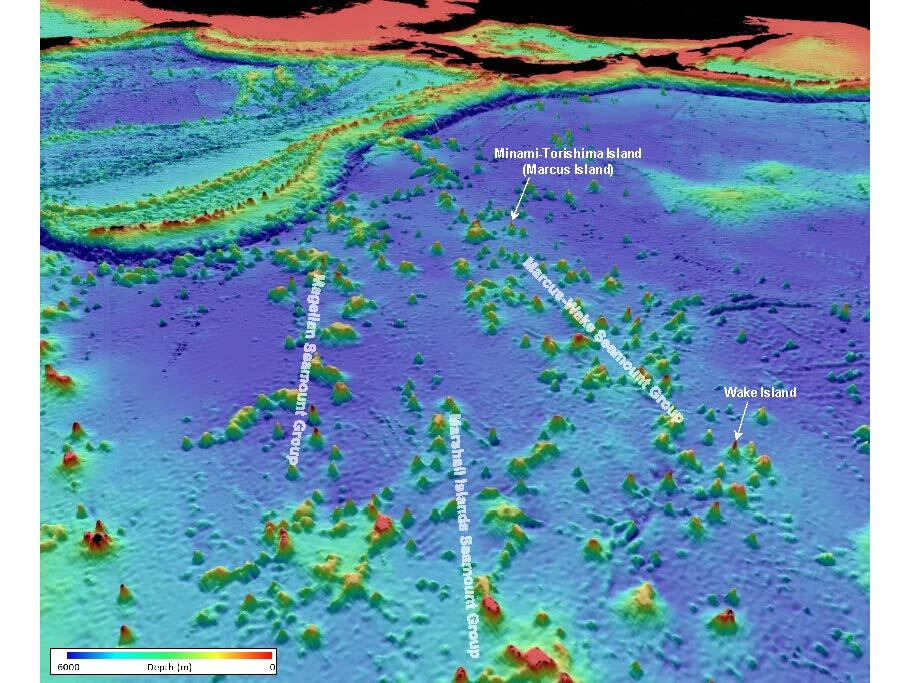Bulletin of the Geological Survey of Japan Top Page
Bulletin of the Geological Survey of Japan Vol.73 No.3 (2022)
Cover figure | Table of Contents | Abstract
Cover figure
3D topographic map of seamounts in Northwest Pacific
A 3D topographic map was created using ETOPO1 published by the NOAA National Centers for Environmental Information (NCEI), oriented northwest with a height enhancement of 10 times. From right to left: the Marcus-Wake Seamount Group, the Marshall Islands Seamount Group, and the Magellan Seamount Group. Most of these seamounts are flat-topped seamounts (Guyots), whose basement consists of basalt that erupted during Cretaceous hotspot volcanism. This area is of interest for the mining of cobalt-rich crusts, since manganese oxides with a thickness of up to 10 cm or more are distributed over exposed rocks. Currently, Japan, China, Republic of Korea, and Russia hold exploration areas here, and resource surveys and environmental assessments are ongoing under the
auspices of the International Seabed Authority (ISA).
(Figure: HINO Hikari (Japan Oil, Gas and Metals National Corporation), Caption: YAMAOKA Kyoko)
Table of Contents
All the pages PDF : 73_03_full.pdf [12MB]
| Title | Author | |
|---|---|---|
| Report | ||
| Late Triassic radiolarians and conodonts from a chert pebble within the Lower Pleistocene Higashihigasa Formation of the Kazusa Group, Boso Peninsula, Japan | ITO Tsuyoshi, MUTO Shun and UTSUNOMIYA Masayuki (p93–101) | 73_03_01.pdf [10MB] |
| Chemical compositions and ages of basalts from seamounts in the Northwest Pacific | YAMAOKA Kyoko, ISHIZUKA Osamu, MOROZUMI Haruhisa and HINO Hikari (p103–135) | 73_03_02.pdf[4MB] |
| Diatom biochronology of the sandy siltstone samples collected from the western margin of the Iwadono Hills, Saitama Prefecture, central Japan | NAYA Tomonori (p137–142) | 73_03_03.pdf [1.5MB] |
Abstract
Late Triassic radiolarians and conodonts from a chert pebble within the Lower Pleistocene Higashihigasa Formation of the Kazusa Group, Boso Peninsula, Japan
ITO Tsuyoshi, MUTO Shun and UTSUNOMIYA Masayuki
Radiolarians and conodonts were obtained from a chert pebble within the conglomerate of the Higashihigasa Formation, Kazusa Group, Boso Peninsula, Japan. Based on the occurrence of radiolarians (Praemesosaturnalis sp. cf. P. heilongjiangensis) and conodonts (Mockina sp.), the chert pebble is considered to be Late Triassic (middle to late Norian) in age. This chert pebble is presumably derived from a Jurassic accretionary complex distributed in its provenance.
Chemical compositions and ages of basalts from seamounts in the Northwest Pacific
YAMAOKA Kyoko, ISHIZUKA Osamu, MOROZUMI Haruhisa and HINO Hikari
As part of the exploration for cobalt-rich ferromanganese crusts in the Northwest Pacific, seamount basalts were collected for chemical composition analysis and K–Ar/Ar–Ar dating. Although the primary chemical compositions of the seamount basalts were not well preserved due to alteration and phosphatization, all 20 seamounts sampled showed typical characteristics of ocean island alkaline basalts. K–Ar dating did not provide reliable ages due to alteration, but Ar–Ar dating provided reliable plateau ages for several seamounts. Formation ages of 67–116 Ma were obtained from the Marcus-Wake Seamount Group, 87 Ma and 105 Ma from the Magellan Seamount Group, and 90 Ma from the Marshall Islands Seamount Group, which were generally consistent with those reported in previous studies.
Diatom biochronology of the sandy siltstone samples collected from the western margin of the Iwadono Hills, Saitama Prefecture, central Japan
NAYA Tomonori
Diatom analysis was performed to determine the depositional age of previously undated sandy siltstone samples from the western margin of the Iwadono Hills, Saitama Prefecture, central Japan. The age of the samples is assigned to the early Middle Miocene according to the occurrence of diatoms that are correlative to the diatom zone NPD4A (Denticulopsis lauta Zone). The occurrence of Cavitatus lanceolatus limits the age of these samples to the interval between biohorizon D41.5 (first occurrence of Cv. lanceolatus: 15.6 Ma) and D43.2 (last occurrence of Cv. lanceolatus: 15.2 Ma). Based on the diatom biostratigraphy and biochronology, these samples can be correlated with the upper part of the Arakawa Formation or the Ichinokawa Formation of the Hiki Group.
Geological Survey of Japan, AIST
- About GSJ
- Our Activities
- Purchase guide
-
Publications and Database
- information
- Bulletin of the Geological Survey of Japan
- bull2025(Vol.76)
- bull2024(Vol.75)
- bull2023(Vol.74)
- bull2022(Vol.73)
- bull2021(Vol.72)
- bull2020(Vol.71)
- bull2019(Vol.70)
- bull2018(Vol.69)
- bull2017(Vol.68)
- bull2016(Vol.67)
- bull2015(Vol.66)
- bull2014(Vol.65)
- bull2013(Vol.64)
- bull2012(Vol.63)
- bull2011(Vol.62)
- bull2010(Vol.61)
- bull2009(Vol.60)
- bull2008(Vol.59)
- bull2007(Vol.58)
- bull2006(Vol.57)
- bull2005(Vol.56)
- bull2004(Vol.55)
- bull2003(Vol.54)
- bull2002(Vol.53)
- bull2001(Vol.52)
- Bulletin of the Geological Survey of Japan(old)
- Annual Report on Active Fault and Paleoearthquake Researches
- Reports, Geological Survey of Japan
- CCOP-GSJ Groundwater Project Report
- CCOP Technical Bulletin
- Cruise Report
- Geological Hazards
- Learning and Education
- GSJ Database Collection
- Collection of links


